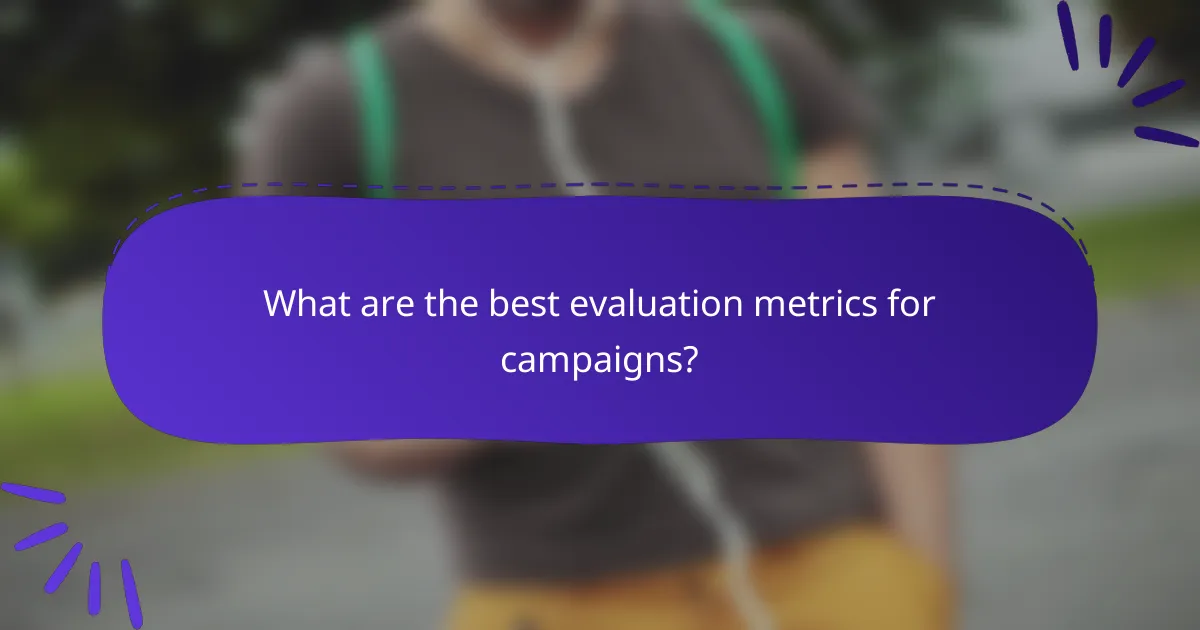Evaluating campaign effectiveness in e-commerce is crucial for understanding how well marketing initiatives achieve their goals. By focusing on key metrics such as sales performance, customer engagement, and return on investment, businesses can gain valuable insights. Post-execution analysis further enhances this understanding by identifying strengths and weaknesses, ultimately guiding future marketing strategies.

How to measure campaign effectiveness in e-commerce?
Measuring campaign effectiveness in e-commerce involves analyzing various metrics that indicate how well a campaign meets its objectives. Key areas of focus include tracking sales performance, customer engagement, and overall return on investment.
Key performance indicators (KPIs)
Key performance indicators (KPIs) are essential metrics that help assess the success of an e-commerce campaign. Common KPIs include website traffic, click-through rates, and average order value. By regularly monitoring these indicators, businesses can identify trends and make informed decisions to optimize future campaigns.
It’s crucial to select KPIs that align with specific campaign goals. For instance, if the goal is brand awareness, focus on metrics like impressions and reach. For sales-driven campaigns, prioritize conversion rates and revenue generated.
Return on investment (ROI)
Return on investment (ROI) measures the profitability of a campaign relative to its cost. To calculate ROI, use the formula: (Net Profit / Cost of Campaign) x 100. A positive ROI indicates that the campaign generated more revenue than it cost, which is the ultimate goal for e-commerce businesses.
When evaluating ROI, consider both direct and indirect costs. Direct costs include advertising expenses, while indirect costs might involve overheads like staff time. Understanding the full scope of costs helps in accurately assessing campaign effectiveness.
Customer acquisition cost (CAC)
Customer acquisition cost (CAC) is the total cost of acquiring a new customer through a campaign. This metric is calculated by dividing the total campaign costs by the number of new customers gained. Keeping CAC low while maintaining quality leads is vital for long-term profitability.
To improve CAC, focus on targeting the right audience and optimizing marketing channels. For example, leveraging social media advertising can yield lower CAC compared to traditional methods if executed effectively.
Conversion rate analysis
Conversion rate analysis evaluates the percentage of visitors who complete a desired action, such as making a purchase. A higher conversion rate indicates a successful campaign. To calculate this, divide the number of conversions by the total number of visitors and multiply by 100.
Improving conversion rates can involve A/B testing different elements of a campaign, such as landing page designs or call-to-action buttons. Small adjustments can lead to significant increases in conversions, enhancing overall campaign effectiveness.
Sales growth metrics
Sales growth metrics track the increase in sales over a specific period, providing insight into the effectiveness of a campaign. This can be measured in terms of percentage growth compared to previous periods or absolute sales figures. Understanding these metrics helps businesses gauge their market performance.
To drive sales growth, analyze customer feedback and market trends. Implementing strategies based on this data, such as promotional offers or product bundling, can stimulate sales and enhance the overall impact of future campaigns.

What are the best evaluation metrics for campaigns?
The best evaluation metrics for campaigns include click-through rate (CTR), engagement rate, cost per acquisition (CPA), and customer lifetime value (CLV). These metrics help assess the effectiveness of marketing efforts and guide future strategies.
Click-through rate (CTR)
Click-through rate (CTR) measures the percentage of users who click on a specific link compared to the total number of users who view the ad or content. A higher CTR indicates that the campaign is effectively attracting attention and prompting action.
To calculate CTR, divide the number of clicks by the number of impressions and multiply by 100. For example, if an ad receives 200 clicks from 10,000 impressions, the CTR would be 2%. Aim for a CTR that aligns with industry benchmarks, which typically range from 1% to 5% depending on the sector.
Engagement rate
Engagement rate measures the level of interaction users have with your content, encompassing likes, shares, comments, and other forms of participation. This metric provides insight into how well your audience connects with your campaign.
To calculate engagement rate, divide the total engagement actions by the total reach or impressions, then multiply by 100. A good engagement rate often falls between 1% and 10%, varying by platform and content type. Focus on creating compelling content that encourages user interaction to improve this metric.
Cost per acquisition (CPA)
Cost per acquisition (CPA) calculates the total cost of acquiring a new customer through a campaign. This metric is crucial for understanding the financial efficiency of your marketing efforts.
To determine CPA, divide the total campaign costs by the number of new customers acquired. For instance, if you spend $1,000 and gain 50 new customers, your CPA would be $20. Aim to keep CPA below the average customer lifetime value to ensure profitability.
Customer lifetime value (CLV)
Customer lifetime value (CLV) estimates the total revenue a business can expect from a single customer throughout their relationship. This metric helps evaluate the long-term value of acquiring new customers through campaigns.
To calculate CLV, consider the average purchase value, purchase frequency, and customer lifespan. For example, if a customer spends $100 per purchase, makes 5 purchases a year, and remains a customer for 3 years, the CLV would be $1,500. Understanding CLV can guide budget allocation for marketing campaigns and customer retention strategies.

How to analyze post-execution campaign data?
Analyzing post-execution campaign data involves assessing the performance metrics to understand the effectiveness of the campaign. This process helps identify strengths and weaknesses, guiding future marketing strategies.
Data collection methods
Effective data collection methods are crucial for accurate campaign analysis. Common approaches include surveys, web analytics, social media insights, and CRM systems. Each method should align with the campaign’s objectives to ensure relevant data is gathered.
For instance, if the goal is to measure customer engagement, social media insights and web analytics can provide valuable metrics. Combining qualitative data from surveys with quantitative data from analytics can offer a comprehensive view of campaign performance.
Data visualization tools
Data visualization tools help transform raw data into easily interpretable formats. Popular tools include Tableau, Google Data Studio, and Microsoft Power BI, which allow users to create charts, graphs, and dashboards that highlight key performance indicators (KPIs).
When selecting a visualization tool, consider factors such as ease of use, integration capabilities, and the specific types of visualizations needed. Effective visualizations can reveal trends and patterns that might not be immediately obvious in raw data.
Statistical analysis techniques
Statistical analysis techniques are essential for deriving insights from campaign data. Common methods include regression analysis, A/B testing, and variance analysis. These techniques help determine the significance of results and the impact of different variables on campaign performance.
For example, A/B testing can be used to compare two versions of an ad to see which performs better. Understanding statistical significance is crucial to avoid drawing incorrect conclusions from the data.

What are common pitfalls in campaign evaluation?
Common pitfalls in campaign evaluation include neglecting qualitative feedback, focusing too much on short-term results, and relying solely on vanity metrics. These mistakes can lead to an incomplete understanding of a campaign’s true impact and effectiveness.
Ignoring qualitative feedback
Ignoring qualitative feedback can significantly undermine campaign evaluation. While quantitative data provides measurable results, qualitative insights from customer surveys, interviews, or social media comments can reveal deeper sentiments and motivations. For example, a campaign may show high sales but low customer satisfaction ratings, indicating potential issues that numbers alone won’t capture.
To avoid this pitfall, incorporate methods for gathering qualitative feedback, such as focus groups or open-ended survey questions. This will provide a more holistic view of how the campaign resonates with the target audience.
Overlooking long-term metrics
Overlooking long-term metrics can skew the perception of a campaign’s success. Many campaigns focus on immediate sales or engagement figures, neglecting metrics that reflect sustained brand loyalty or customer retention. For instance, a campaign might generate a spike in sales but fail to convert new customers into repeat buyers.
To ensure a comprehensive evaluation, track metrics such as customer lifetime value (CLV) and repeat purchase rates over time. This approach helps assess the lasting impact of a campaign and informs future strategies.
Relying solely on vanity metrics
Relying solely on vanity metrics can create a misleading picture of campaign performance. Metrics like social media likes or website visits may look impressive but do not necessarily correlate with meaningful business outcomes. For example, a high number of likes on a post does not guarantee increased sales or brand loyalty.
Focus on actionable metrics that align with business objectives, such as conversion rates or return on investment (ROI). By prioritizing these metrics, you can better evaluate the effectiveness of your campaigns and make informed decisions moving forward.

How to improve future campaigns based on analysis?
To enhance future campaigns, leverage insights gained from post-execution analysis to refine strategies and execution. Focus on key metrics, audience feedback, and performance data to identify areas for improvement.
Implementing A/B testing
A/B testing allows marketers to compare two versions of a campaign element to determine which performs better. By testing variations in headlines, images, or calls to action, you can gain valuable insights into what resonates with your audience.
Consider running A/B tests with a sample size that reflects your target market. Aim for a testing duration of at least one week to gather sufficient data. Avoid making decisions based on inconclusive results from small samples.
Refining target audience segmentation
Refining your target audience segmentation can significantly enhance campaign effectiveness. Use data analytics to identify distinct groups within your audience based on demographics, behaviors, and preferences.
Consider creating personas that represent your ideal customers. Tailor your messaging and offers to each segment, which can lead to higher engagement and conversion rates. Regularly revisit and adjust your segments as market conditions and consumer behaviors evolve.
Adjusting marketing channels
Evaluating and adjusting your marketing channels is crucial for maximizing reach and impact. Analyze which channels delivered the best results in previous campaigns and allocate resources accordingly.
For instance, if social media platforms yielded higher engagement than email campaigns, consider increasing your investment in social media advertising. Monitor channel performance continuously and be ready to pivot strategies based on real-time data and trends.

What frameworks can guide campaign evaluation?
Several frameworks can effectively guide campaign evaluation, helping organizations assess their performance and impact. Key frameworks include the SMART criteria, the Logic Model, and the Return on Investment (ROI) analysis, each offering unique perspectives on measuring success.
SMART criteria
The SMART criteria stand for Specific, Measurable, Achievable, Relevant, and Time-bound. This framework helps ensure that campaign objectives are clear and quantifiable, allowing for straightforward evaluation. For example, instead of a vague goal like “increase brand awareness,” a SMART objective would be “increase website traffic by 20% over three months.”
When using SMART, focus on setting realistic targets that align with your overall business goals. Regularly review progress against these criteria to make necessary adjustments during the campaign. This iterative approach can enhance effectiveness and ensure alignment with strategic objectives.
Logic Model
The Logic Model is a visual representation that links resources, activities, outputs, and outcomes of a campaign. It helps stakeholders understand how inputs translate into desired results, making it easier to identify areas for improvement. For instance, if a campaign aims to boost sales, the model would outline the necessary resources, marketing activities, and expected sales outcomes.
Utilizing a Logic Model involves mapping out each component clearly and regularly updating it based on campaign performance. This framework aids in pinpointing bottlenecks and ensuring that all activities contribute toward achieving the intended outcomes.
Return on Investment (ROI) analysis
ROI analysis calculates the financial return generated by a campaign relative to its costs. This metric is crucial for understanding the economic impact of marketing efforts. A simple formula to calculate ROI is: (Net Profit / Cost of Campaign) x 100. For example, if a campaign costs $10,000 and generates $15,000 in profit, the ROI would be 50%.
When conducting an ROI analysis, consider both direct and indirect benefits, such as increased customer loyalty or brand equity. Regularly assessing ROI can guide future investment decisions and help allocate resources more effectively across campaigns.


